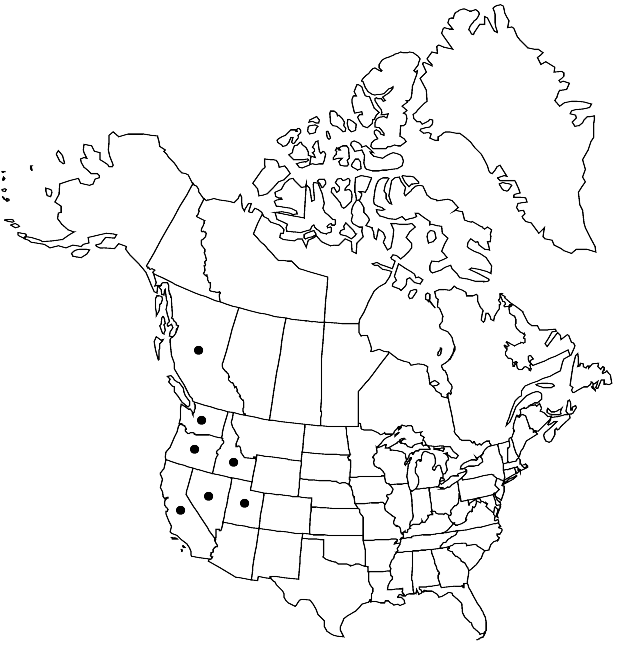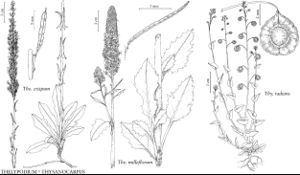Difference between revisions of "Thelypodium milleflorum"
Bot. Gaz. 52: 263. 1911.
FNA>Volume Importer |
imported>Volume Importer |
||
| (5 intermediate revisions by 2 users not shown) | |||
| Line 6: | Line 6: | ||
|place=52: 263. 1911 | |place=52: 263. 1911 | ||
|year=1911 | |year=1911 | ||
| + | }} | ||
| + | |special_status={{Treatment/ID/Special_status | ||
| + | |code=F | ||
| + | |label=Illustrated | ||
| + | }}{{Treatment/ID/Special_status | ||
| + | |code=E | ||
| + | |label=Endemic | ||
}} | }} | ||
|basionyms= | |basionyms= | ||
| Line 11: | Line 18: | ||
|name=Thelypodium laciniatum var. milleflorum | |name=Thelypodium laciniatum var. milleflorum | ||
|authority=(A. Nelson) Payson | |authority=(A. Nelson) Payson | ||
| + | |rank=variety | ||
}} | }} | ||
|hierarchy=Brassicaceae;Brassicaceae tribe Thelypodieae;Thelypodium;Thelypodium milleflorum | |hierarchy=Brassicaceae;Brassicaceae tribe Thelypodieae;Thelypodium;Thelypodium milleflorum | ||
| Line 34: | Line 42: | ||
-->{{#Taxon: | -->{{#Taxon: | ||
name=Thelypodium milleflorum | name=Thelypodium milleflorum | ||
| − | |||
|authority=A. Nelson | |authority=A. Nelson | ||
|rank=species | |rank=species | ||
| Line 48: | Line 55: | ||
|publication title=Bot. Gaz. | |publication title=Bot. Gaz. | ||
|publication year=1911 | |publication year=1911 | ||
| − | |special status= | + | |special status=Illustrated;Endemic |
| − | |source xml=https:// | + | |source xml=https://bitbucket.org/aafc-mbb/fna-data-curation/src/2e0870ddd59836b60bcf96646a41e87ea5a5943a/coarse_grained_fna_xml/V7/V7_1286.xml |
|tribe=Brassicaceae tribe Thelypodieae | |tribe=Brassicaceae tribe Thelypodieae | ||
|genus=Thelypodium | |genus=Thelypodium | ||
Latest revision as of 22:31, 5 November 2020
Biennials; somewhat glaucous, glabrous (except petioles). Stems (hollow), branched distally, (1.8–)4.5–13(–21) dm. Basal leaves (and proximal cauline): petiole (1–)1.8–9.5(–13) cm, ciliate; blade often oblong, sometimes ovate or lanceolate, (3.8–)6–23(–28) cm × (9–)20–65(–100) mm, margins usually dentate, sometimes sinuate, rarely repand. Cauline leaves petiolate; blade lanceolate, similar to basal, smaller distally, margins dentate or entire. Racemes dense, slightly elongated in fruit (to 10 dm, flower buds narrowly oblong). Fruiting pedicels erect distally, strongly curved upward, stout, (1.5–)2.5–5(–7) mm, slightly flattened at base. Flowers: sepals erect, oblong to linear-oblong, (4–)4.5–8(–9) × 1–2 mm; petals white, spatulate to oblanceolate, (7–)9–15(–16) × 1–2 mm, claw strongly differentiated from blade [(3–)3.5–5.5(–6) mm, widest at base]; nectar glands confluent, median and lateral; filaments subequal, (6–)7–14.5(–15.5) mm; anthers exserted, linear to narrowly oblong, 2.5–4.5(–6) mm, circinately coiled, (apiculate); gynophore (0.5–)1–4(–6) mm. Fruits erect, (subappressed to rachis), torulose, somewhat tortuous, terete, (1.8–)3.3–8(–10) cm × (0.7–)1–1.5(–1.8) mm; ovules 50–78 per ovary; style usually cylindrical, rarely subclavate, (0.5–)0.7–1.5(–3) mm. Seeds (0.7–)1–1.5(–2) × 0.5–0.7(–1) mm. 2n = 26.
Phenology: Flowering Apr–Aug.
Habitat: Sand dunes, sagebrush and desert shrub communities
Elevation: 150-2200 m
Distribution

B.C., Calif., Idaho, Nev., Oreg., Utah, Wash.
Discussion
Selected References
None.
